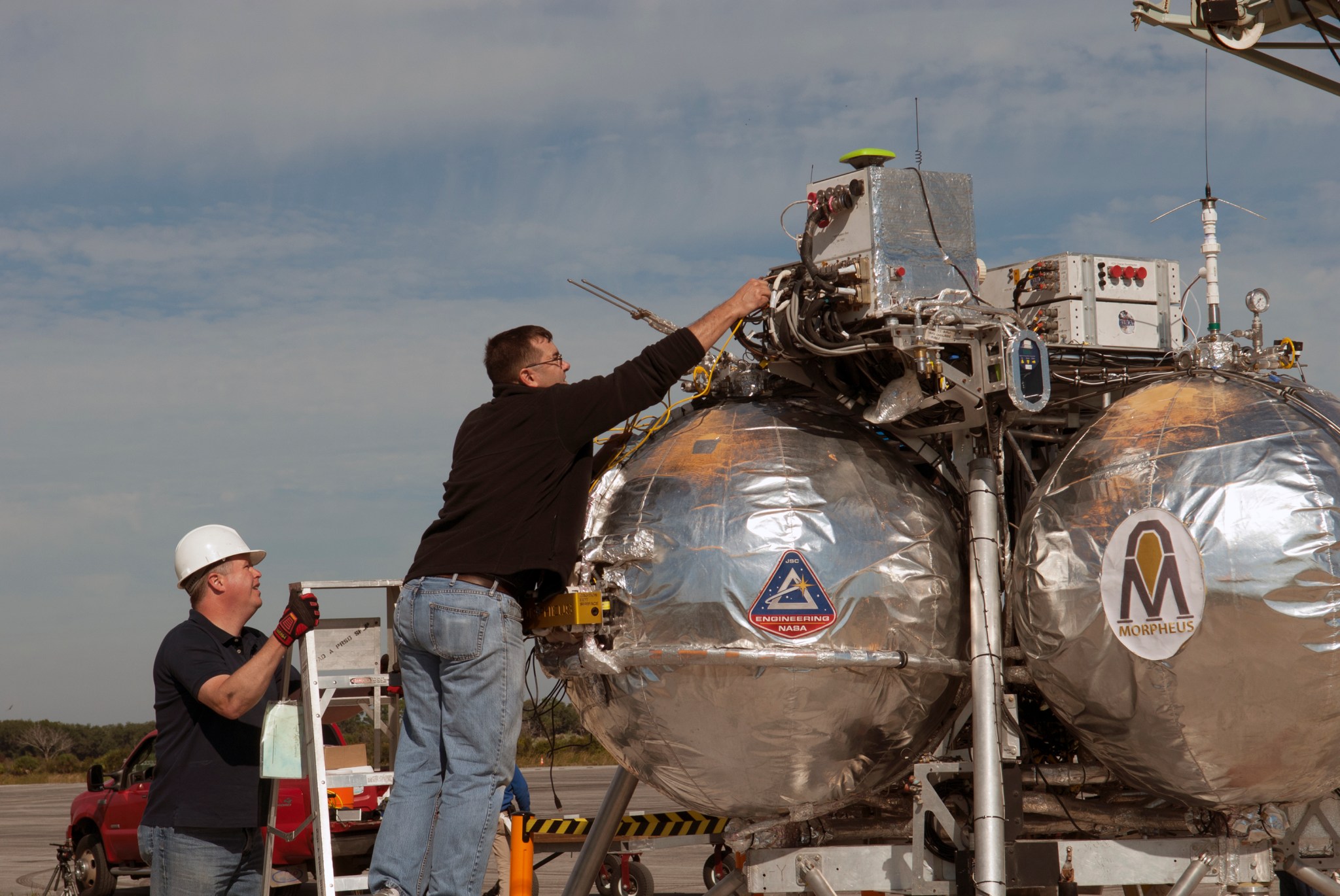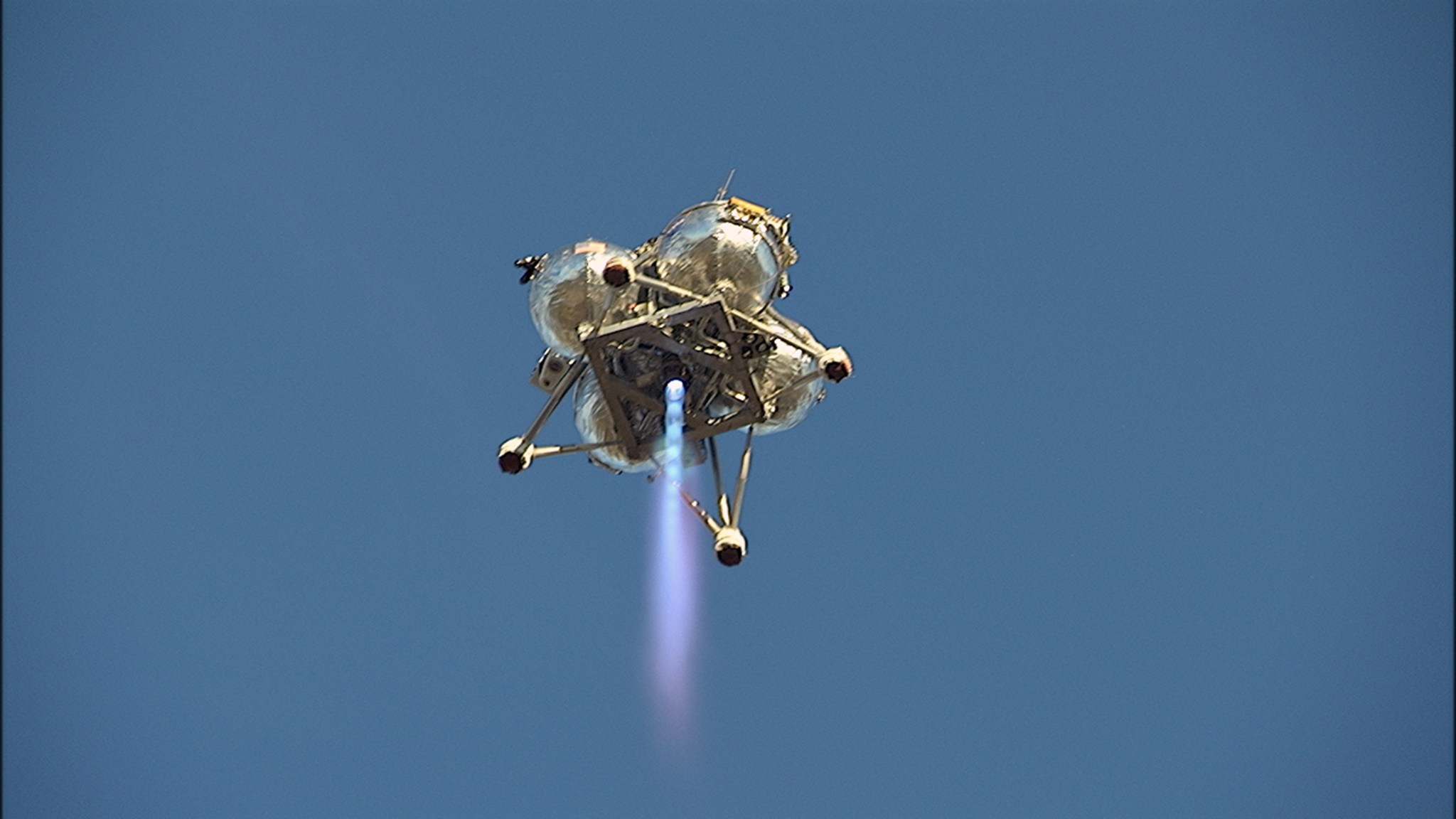NASA’s Project Morpheus team of engineers and technicians completed the final series of flight tests on the prototype lander at NASA’s Kennedy Space Center in Florida. The project was created to provide a way to test advanced spacecraft systems that could be incorporated into future spacecraft for exploration missions to the moon, an asteroid or Mars.
Morpheus is a prototype lander that can use advanced sensors to automatically fly and navigate around hazards and land in a predetermined location within a simulated rocky planet environment. This autonomous landing and hazard avoidance technology (ALHAT) is designed to enable a spacecraft to identify and descend to a safe landing site that is relatively flat and free of large boulders, rocks and craters. Morpheus also is capable of vertical takeoff and landing using precision landing technologies and a liquid oxygen and liquid methane propulsion system.

Taking baby steps at first, the team performed several tethered tests at the agency’s Johnson Space Center in Houston with just the lander to check its functionality. The lander was suspended by a crane and the main engine was ignited. The vehicle, attached to the crane by a tether line, rose a short distance, performed a series of maneuvers for about one minute, and then descended to take up the slack in the tether. Results of several tethered tests proved the system was ready for the free-flight phase of the testing, and the vehicle was shipped to Kennedy, where one final tether test was conducted.
From December 2013 to December 2014, Morpheus completed 13 free flight tests at the north end of Kennedy’s Shuttle Landing Facility, with seven of them occurring to demonstrate lander performance without ALHAT, and the remaining 6 with ALHAT installed. A transportable, concrete launch pad was constructed and a flame trench was added, prior to this series of tests, to help reduce the effects of harsh noise and vibrations on the lander during a launch.
In the series of baseline tests, the Morpheus team first evaluated the lander’s ability to take off and land without using the ALHAT sensors, continually expanding the flight envelope with each test, soaring higher and traveling farther and faster each time. Then the team added the ALHAT system to the spacecraft and gradually increased the difficulty of the tests.
“The Morpheus/ALHAT free flights at Kennedy are a key step in the development and demonstration of several new technologies for future robotic and human planetary exploration missions,” said Edward Robertson, ALHAT deputy project manager at Johnson Space Center in Houston.
ALHAT’s three sensors scan for rocks, craters, and excessively sloped areas, all hazards to the lander, and relay safe landing information to Morpheus. The three main sensors are a laser altimeter and Doppler Light Detection and Ranging (LIDAR) velocimeter – both used for navigation – and a flash LIDAR-based hazard detection system.

The system autonomously selects its landing target, modifies the route and lands the vehicle in the safest area as analyzed by the sensor package. Following the integration of ALHAT, free-flight tests were performed, simulating a Hazard Detection Phase flight path similar to a lunar or mars landing approach, with the Morpheus vehicle always touching down within inches of its intended safe-zone target in the hazard field.
Following the successful execution of a night flight May 28, 2014 (designated FF14 since two free flights had been attempted in 2012), the team took a 6-month testing hiatus to review flight data and make improvements.
“We continued to maintain a constant dry-air purge on the flash LIDAR sensor to prevent damage to the array from high humidity,” said Greg Gaddis, the Morpheus/ALHAT site manager at Kennedy. “We also had to recertify the liquefied natural gas and the liquid oxygen tankers for use.”
Gaddis said the team also performed a load test of the crane hardware that would lift Morpheus into the air, recertifying it for use in preparation for the tether tests.
The final series of tests was completed at Kennedy in late 2014 to verify its autonomous lift off and landing capabilities and hazard detection ability. The final tests utilized the integrated hardware and software updates that were identified as a result of previous testing at Kennedy and further analysis at Johnson.
The action took place at the north end of the landing facility, using the same hazard field that was used to test ALHAT. The vehicle’s three-beam Doppler velocimeter sensor used for navigation was moved from the left rear quadrant to the front of the vehicle’s forward oxygen tank to eliminate interference from the engine plume and surrounding heated air that was seen in previous free-flight testing. Navigation software also was reformulated in preparation for the first closed-loop ALHAT flight. A closed-loop flight means that ALHAT alone would actually fly the lander to the newly designated safe landing zone without assistance from the control center as was used in previous tests.
Following a successful data and test readiness review, Morpheus Project Manager Jon Olansen, based at Johnson, declared the lander was ready for the final Hazard Detection Phase free-flight to test the ALHAT upgrades.
After a series of weather delays, Morpheus successfully completed its final free-flight test Dec. 15, 2014. The vehicle flew on closed-loop ALHAT navigation using its upgraded sensor suite during the entire flight, traversed above the hazard field, and then softly touched down within about four feet of the targeted landing location.
“The ALHAT team reviewed the data and determined the navigation performance was successful and satisfied the Technology Readiness Level objective of the flight-test campaign,” said Olansen.
Upon reviewing all of the free-flight test data, the team agreed that the Morpheus/ALHAT project had met the objectives identified. These included achieving precision landing, certifying flight software and high-fidelity simulation, the development and successful operation of a liquid oxygen (LOX)/liquid methane (LCH4) propulsion engine, feed system and tanks, integrating the vehicle, and evaluating ground systems and operations.
“We believe the cumulative testing has satisfied the intent of demonstrating integrated LOX-methane propulsion capabilities and ALHAT closed-loop performance in a relevant dynamic flight environment,” Olansen said.
After completion of the tests at Kennedy, the team removed the ALHAT sensor system from Morpheus, packed it, and shipped it back to Langley Research Center in Hampton, Virginia, while the Morpheus vehicle and ground support equipment were returned to Johnson.
Project Morpheus is managed under the Advanced Exploration Systems Division in NASA’s Human Exploration and Operations Mission Directorate. Morpheus and ALHAT are examples of the partnerships that exist within the agency since eight of the 10 NASA centers contributed time, energy and resources to both.
For more information about Morpheus, visit http://morpheuslander.jsc.nasa.gov.
To watch a video of Morpheus testing at Johnson Space Center, visit http://morpheuslander.blogspot.com/2013/05/and-so-we-begin-again.html.




























